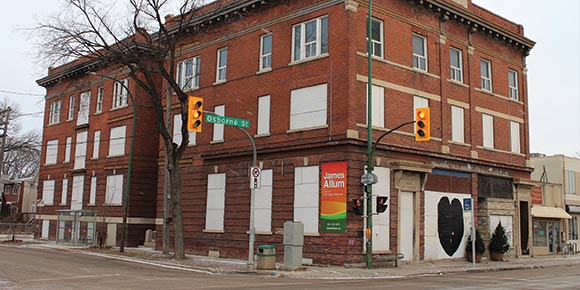By the time the neighbourhoods of Riverview and Lord Roberts opened up for urban development in the early 1900s, south Osborne Street was already a well-travelled thoroughfare thanks to the “Park Line” street car line that began ferrying Winnipegers to and from River Park in 1891.
More than a century later, the street is as popular as ever with its interesting mix of commercial and residential buildings.
Ambulance Station No. 10 (1913)
524 Osborne Street
The South Osborne Ratepayers’ Association was formed in early 1913 to push for improved civic services for the developing Lord Roberts and Riverview neighbourhoods. At the top of their list was to get the city moving on the construction of a promised fire station at Osborne and Arnold.
In August 1913, the tender for the construction of that station was awarded and it was in service by the end of the year.
Fire Station No. 15, as it was originally known, was designed by Alexander Neville who, along with his brother, William, had designed over a dozen Winnipeg fire halls between 1904 and 1914. The $20,000, two-storey building contained sleeping quarters upstairs, stables with a hayloft and an adjoining 22-meter tall tower for drying hoses.
Given the station’s distance from other city offices, it has provided additional municipal services throughout its history, such as being a polling station, bicycle licence issuer and an unemployment registration office during the Depression.
After the creation of the “Unicity” of Winnipeg in 1972, one of the big challenges was merging eight different municipal fire departments into one. The result was that seven of the city’s 24 fire halls were closed, including Fire Station No. 15.
When the city got around to merging its ambulance services in 1975, the building was reopened as an ambulance station with its own radio dispatch centre.
In 1995, the building underwent a major renovation that included squaring the vehicle entrances and the construction of a new garage space to the south.
The Rubin Block/Morley Apartments (1915)
270 Morley Avenue
This three-storey, mixed-use building was designed by architect Max Zev Blankstein whose work includes the Merchants Hotel on Selkirk and Uptown Theatre on Academy. The investor who paid for its construction was Reubin Cohen.
In 1924, an ownership change saw the name
“Rubin Block” replaced by “Morley Apartments”, though the stone tablet on the cornice was not
altered to reflect the new name.
The residential component of the building could be accessed from either Osborne or Morley and originally contained 20 apartment units. Interestingly, there was no suite “13”, just a suite 12 and 12 ½. Its original lineup of tenants in 1915-16 had jobs such as travelling salesman, well driller, fireman and various positions within the CNR.
The main floor of the Rubin Block contained three retail spaces. The corner space became home to the city’s third Merchants Bank branch in 1919. When Merchants and the Bank of Montreal merged in 1922, it carried on as a BMO until the early 1950s.
The middle retail space was home to Allan Reid’s Drug Store from 1922 to 1952, and the smallest space was home to a watch maker, then a barber shop.
In 1962, the entire main floor became home to a Goodwill Industries shop which lasted until the early 2000s.
The 2000s have not been kind to the building. A basement fire in 2006 damaged some of the suites, and a more devastating third floor fire in 2014 forced the building to be shut down. It has been vacant ever since.
Our Lady of Victory Memorial Parish (1946, 1954)
249 Arnold Street
In May 1946, Winnipeg Archbishop A. A. Sinnott announced that a Roman Catholic Church would be constructed in South Fort Rouge adjacent to St. Mary’s Cemetery. It would be the first new parish built in the city in a couple of decades.
The man chosen to be its parish priest was James K. MacIsaac. He joined the Chaplaincy Corps of the Canadian Armed Forces in World War II, achieving the rank of Lieutenant Colonel and serving as the chief Catholic clergy in the Mediterranean region. Because of his service, it was decided that the church would also be a memorial to those from the Winnipeg Archdiocese who were killed in the war.
Initially, the congregation worshipped in the unheated chapel building in the neighbouring St. Mary’s Cemetery. When it got too cold, they moved to the Park Theatre and began fundraising for a permanent home.
The basement of the church, which can seat 500, was opened in March 1949 and hosted worship services and a Catholic elementary school. The congregation continued to fundraise to build the upper level.
That upper level was designed by Winnipeg-born architect Roy Sellors, whose works include the Transcona Public Library and more than a dozen churches around the city. The flat-roofed, modernist building is split level and is in the shape of a crucifix. It is said to have been inspired by a Franciscan church in Burlington, Vermont.
The church, which cost $45,000 to build and seats over 400, was dedicated in December 1954.
One unique feature of the interior of the church are the stations of the cross painted on the plywood panelling by Irish artist Peter Carey. The images were said to be controversial at the time as they depicted a more modern looking Christ with a trimmed beard and short hair.
Christian writes about local history on his blog, West End Dumplings.



